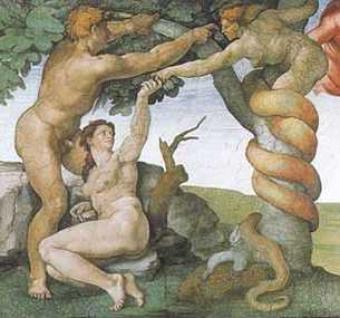Adam and Eve, The Fall of Man and Jesus Christ
That man was originally created a perfect being, and is now only a fallen and broken remnant of what he once was, we have seen to be a piece of mythology, not only unfounded in fact, but, beyond intelligent question, proved untrue. What, then, is the significance of the exposure of this myth? What does its loss as a scientific fact, and as a portion of Christian dogma, imply? It implies that with it—although many Christian divines who admit this to be a legend, do not, ]or do not profess, to see it—must fall the whole Orthodox scheme, for upon this MYTH the theology of Christendom is built. The doctrine of the inspiration of the Scriptures, the Fall of man, his total depravity, the Incarnation, the Atonement, the devil, hell, in fact, the entire theology of the Christian church, falls to pieces with the historical inaccuracy of this story, for upon it is it built; 'tis the foundation of the whole structure.[17:1]
According to Christian dogma, the Incarnation of Christ Jesus had become necessary, merely because he had to redeem the evil introduced into the world by the Fall of man. These two dogmas cannot be separated from each other. If there was no Fall, there is no need of an atonement, and no Redeemer is required. Those, then, who consent in recognizing in Christ Jesus a Godand Redeemer, and who, notwithstanding, cannot resolve upon admitting the story of the Fall of man to be historical, should exculpate themselves from the reproach of inconsistency. There are a great number, however, in this position at the present day.
Although, as we have said, many Christian divines do not, or do not profess to, see the force of the above argument, there are many who do; and they, regardless of their scientific learning, cling to these old myths, professing to believe them, well knowing what must follow with their fall. The following, though written some years ago, will serve to illustrate this style of reasoning.
The Bishop of Manchester (England) writing in the "Manchester Examiner and Times," said:
"The very foundation of our faith, the very basis of our hopes, the very nearest and dearest of our consolations are taken from us, when one line of that sacred volume, on which we base everything, is declared to be untruthful and untrustworthy."
The "English Churchman," speaking of clergymen who have "doubts," said, that any who are not throughly persuaded "that the Scriptures cannot in any particular be untrue," should leave the Church.
The Rev. E. Garbett, M. A., in a sermon preached before the University of Oxford, speaking of the "historical truth" of the Bible, said:
[Pg 18]
"It is the clear teaching of those doctrinal formularies, to which we of the Church of England have expressed our solemn assent, and no honest interpretation of her language can get rid of it."
And that:
"In all consistent reason, we must accept the whole of the inspired autographs, or reject the whole."
Dr. Baylee, Principal of a theological university—St. Aiden's College—at Birkenhead, England, and author of a "Manual," called Baylee's "Verbal Inspiration," written "chiefly for the youths of St. Aiden's College," makes use of the following words, in that work:
"The whole Bible, as a revelation, is a declaration of the mind of God towards his creatures on all the subjects of which the Bible treats."
"The Bible is God's word, in the same sense as if he had made use of no human agent, but had Himself spoken it."
"The Bible cannot be less than verbally inspired. Every word, every syllable, every letter, is just what it would be, had God spoken from heaven without any human intervention."






